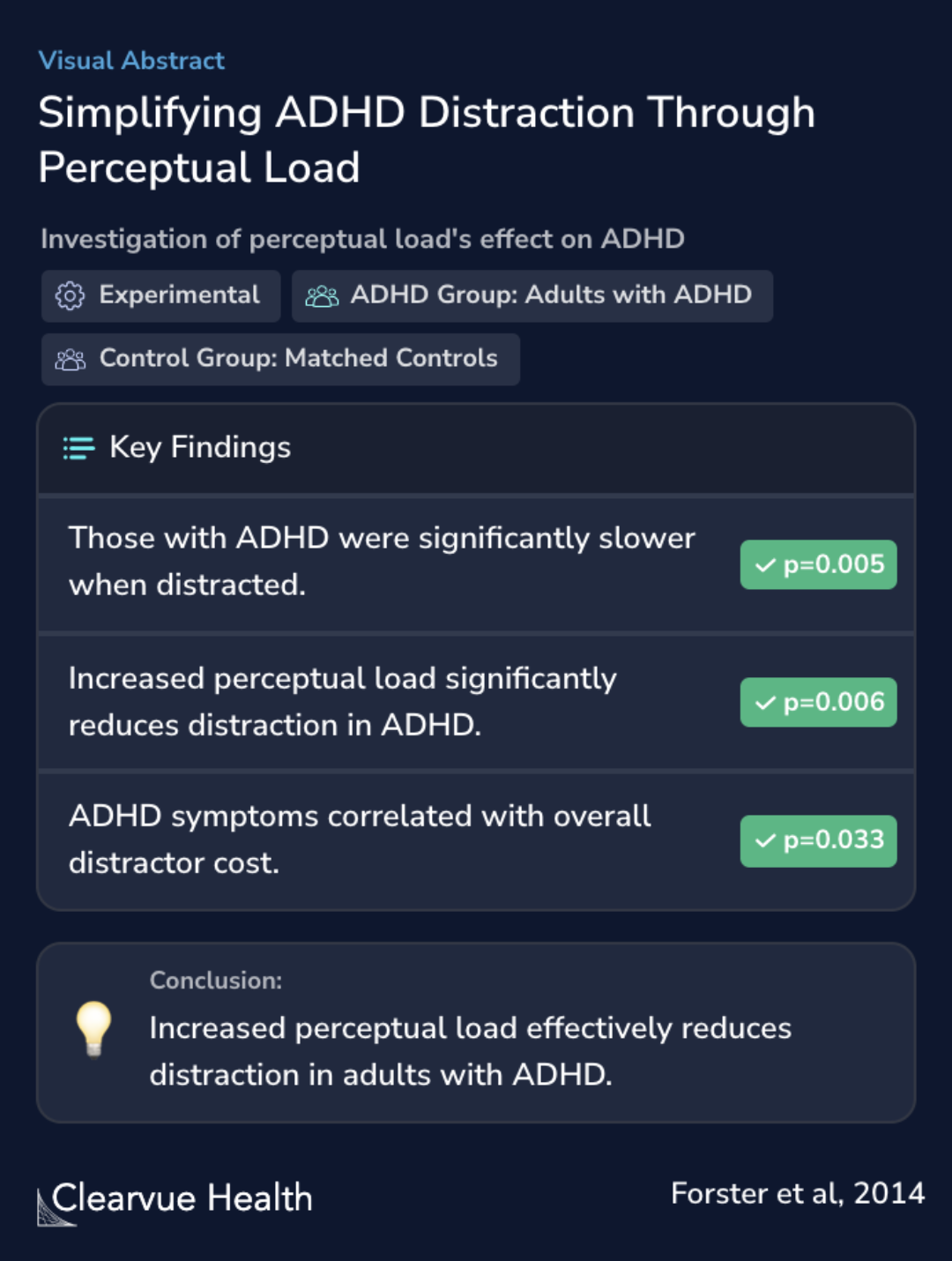Plugging the attention deficit: perceptual load counters increased distraction in ADHD
Simplifying ADHD Distraction Through Perceptual Load
Sophie Forster, David J Robertson, Alistair Jennings, Philip Asherson, Nilli Lavie

Objectives
The study aimed to better understand and address the increased vulnerability to distraction in individuals with Attention-Deficit Hyperactivity Disorder (ADHD). It applied the Load Theory of attention to examine if heightened perceptual load could enhance focus and reduce distraction in adults with ADHD. This approach was based on previous research showing that increased perceptual load can improve attentional focus in nonclinical populations. Increased vulnerability to extraneous distraction is a key symptom of Attention-Deficit Hyperactivity Disorder (ADHD), which may have particularly disruptive consequences.
The present study examines whether adults with ADHD can also benefit from conditions of high perceptual load to improve their focused attention abilities.
Increased vulnerability to extraneous distraction is a key symptom of Attention-Deficit Hyperactivity Disorder (ADHD), which may have particularly disruptive consequences. Here we apply Load Theory of attention to increase understanding of this symptom, and to explore a potential method ...
Methods
In the study, adults with ADHD and matched controls were tested using a novel distraction measure under varying perceptual loads. The experiment involved a letter search task where participants had to ignore irrelevant, visually striking distractions (colorful cartoon images) that appeared in 10% of the trials. This setup was designed to mimic the type of distraction typically encountered by individuals with ADHD.
Researchers tested adults with ADHD and age- and IQ-matched controls on a novel measure of irrelevant distraction under load, designed to parallel the form of distraction that is symptomatic of ADHD. During a letter search task, in which perceptual load was varied through search set size, participants were required to ignore salient yet entirely irrelevant distractors (colorful images of cartoon characters) presented infrequently (10% of trials).
We tested adults with ADHD and age- and IQ-matched controls on a novel measure of irrelevant distraction under load, designed to parallel the form of distraction that is symptomatic of ADHD. During a letter search task, in which perceptual load was varied through search set size, partici...
Results
The presence of these distractors produced a significantly greater interference effect on the search RTs for the adults with ADHD compared with controls. Perceptual load, however, significantly reduced distractor interference for the ADHD group and was as effective in reducing the elevated distractor interference in ADHD as it was for controls.
The presence of these distractors produced a significantly greater interference effect on the search RTs for the adults with ADHD compared with controls, p = .005, ηp² = .231. Perceptual load, however, significantly reduced distractor interference for the ADHD group and was as effective ...
Conclusions
These findings clarify the nature of the attention deficit underlying increased distraction in ADHD, and demonstrate a tangible method for overcoming it.
These findings clarify the nature of the attention deficit underlying increased distraction in ADHD, and demonstrate a tangible method for overcoming it.
Context
A study conducted by van Mourik et al. in 2007 found that children with ADHD had increased orienting to distractions, but it improved their performance. This highlights that distractions might not always negatively affect individuals with ADHD; in some cases, they can be beneficial. This ties into the current study's exploration of distraction in ADHD, providing a contrasting perspective on how individuals with ADHD interact with distractions.
Research by Hirvikoski et al. in 2011 examined the effects of skills-focused therapy on adults with ADHD. It concluded that adults who received structured skills training were more likely to experience improvements in their ADHD symptoms compared to a control group. This research complements the current study by showing another effective approach to managing ADHD symptoms, indicating the potential benefits of various interventions, including both behavioral and perceptual load strategies